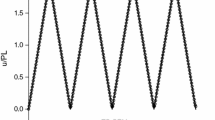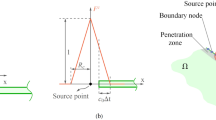Abstract
This work is concerned with the development of a D-BEM approach to the solution of 2D scalar wave propagation problems. The time-marching process can be accomplished with the use of the Houbolt method, as usual, or with the use of the Newmark method. Special attention was devoted to the development of a procedure that allows for the computation of the initial conditions contributions. In order to verify the applicability of the Newmark method and also the correctness of the expressions concerned with the computation of the initial conditions contributions, four examples are presented and the D-BEM results are compared with the corresponding analytical solutions.
Similar content being viewed by others
References
Beskos DE (1997) Boundary elements in dynamic analysis: part II (1986–1996). Appl Mech Rev 50: 149–197
Beskos DE (2003) Dynamic analysis of structures and structural systems. In: Beskos DE, Maier G (eds) Boundary element advances in solid mechanics. CISM, Udine
Mansur WJ (1983) A Time-stepping technique to solve wave propagation problems using the boundary element method. Ph.D. Thesis, University of Southampton
Dominguez J (1993) Boundary elements in dynamics. Computational Mechanics Publications, Southampton, Boston
Carrer JAM, Mansur WJ (2002) Time-dependent fundamental solution generated by a not impulsive source in the boundary element method analysis of the 2D scalar wave equation. Commun Numer Methods Eng 18: 277–285
Demirel V, Wang S (1987) Efficient boundary element method for two-dimensional transient wave propagation problems. Appl Math Model 11: 411–416
Mansur WJ, deLima-Silva W (1992) Efficient time truncation in two-dimensional BEM analysis of transient wave propagation problems. Earthquake Eng Struct Dyn 21: 51–63
Soares D Jr, Mansur WJ (2004) Compression of time generated matrices in two-dimensional time-domain elastodynamic BEM analysis. Int J Numer Methods Eng 61: 1209–1218
Carrer JAM, Mansur WJ (2006) Solution of the two-dimensional scalar wave equation by the time-domain boundary element method: lagrange truncation strategy in time integration. Struct Eng Mech 23: 263–278
Carrer JAM, Mansur WJ (2004) Alternative time-marching schemes for elastodynamic analysis with the domain boundary element method formulation. Comput Mech 34: 387–399
Hatzigeorgiou GD, Beskos DE (2002) Dynamic elastoplastic analysis of 3D structures by the domain/boundary element method. Comput Struct 80: 339–347
Kontoni DPN, Beskos DE (1993) Transient dynamic elastoplastic analysis by the dual reciprocity BEM. Eng Anal Bound Elements 12: 1–16
Partridge PW, Brebbia CA, Wrobel LC (1992) The dual reciprocity boundary element method. Computational Mechanics Publications, Southampton, Boston
Agnantiaris JP, Polyzos D, Beskos DE (1996) Some studies on dual reciprocity BEM for elastodynamic analysis. Comput Mech 17: 270–277
Agnantiaris JP, Polyzos D, Beskos DE (1998) Three-dimensional structural vibration analysis by the dual reciprocity BEM. Comput Mech 21: 372–381
Houbolt JC (1950) A recurrence matrix solution for the dynamic response of elastic aircraft. J Aeronaut Sci 17: 540–550
Souza LA, Carrer JAM, Martins CJ (2004) A fourth order finite difference method applied to elastodynamics: finite element and boundary element formulations. Struct Eng Mech 17: 735–749
Chien CC, Chen YH, Chuang CC (2003) Dual reciprocity BEM analysis of 2D transient elastodynamic problems by time-discontinuous galerkin FEM. Eng Anal Bound Elements 27: 611–624
Bathe KJ (1996) Finite element procedures. Prentice Hall Inc., New Jersey
Cook RD, Malkus DS, Plesha ME (1989) Concepts and applications of finite element analysis. Wiley, New York
Newmark NM (1959) A method of computation for structural dynamics. ASCE J Eng Mech Div 85: 67–94
Carrer JAM, Mansur WJ (1996) Time-Domain BEM analysis for the 2D scalar wave equation: initial conditions contributions to space and time derivatives. Int J Numer Methods Eng 39: 2169–2188
Stephenson G (1970) An introduction to partial differential equations for science students. Longman, London
Kreyszig E (1999) Advanced engineering mathematics, 8th edn. Wiley, New York
Abreu AI, Mansur WJ, Carrer JAM (2006) Initial conditions contributions in a BEM formulation based on the convolution quadrature method. Int J Numer Methods Eng 67: 417–434
Author information
Authors and Affiliations
Corresponding author
Rights and permissions
About this article
Cite this article
Carrer, J.A.M., Mansur, W.J. & Vanzuit, R.J. Scalar wave equation by the boundary element method: a D-BEM approach with non-homogeneous initial conditions. Comput Mech 44, 31–44 (2009). https://doi.org/10.1007/s00466-008-0353-4
Received:
Accepted:
Published:
Issue Date:
DOI: https://doi.org/10.1007/s00466-008-0353-4




